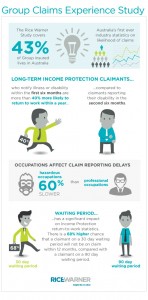
MEDIA RELEASE Group Claims Experience 2015 “What makes us claim? Australian first Group Insurance Industry Statistics reveal unique insights”
- On 15/09/2015
The quicker to claim, the speedier the return to work for 40 percent of Australians who seek insurance benefits from their Group (Superannuation) income protection policies.
This is one of many unique insights into the underlying dynamics of Australia’s Group Risk Insurance sector, uncovered by new Rice Warner research.
The Rice Warner Group Insurance 2010 to 2013 Industry Tables, released today, combine data sourced from 16 large Australian superannuation funds. Rice Warner has devised market-leading benchmark statistics giving greater insight into key areas such as probabilities of claim, and for Income Protection, the probabilities of ceasing to claim.
“Group Insurance claims are a complex area. The greater the available data volumes, the more we are can drill down to discover credible findings,” said Rice Warner Head of Consulting and Research, Jenni Baxter.
“The discovered probabilities do not directly correspond to any one Superannuation Fund (either included or excluded from the study) but they do provide a critical framework for pricing and relative models against which actuaries can measure their Fund’s experience.”
Ms Baxter said industry benchmark statistics are more readily available for the Retail Insurance sector, whereas Group pricing actuaries have resorted to out-dated statistics from different markets or even relying on data sourced from offshore.
“The Rice Warner tables have enabled the Australian Group Life industry to access current and credible data for pricing, lifting us to world’s best practices,” she said.
“We are excited that these new results will make a positive difference, enabling more confident pricing decisions to be made that benefit the whole industry. We thank participating funds for their support.”
Key insights from the Report:
- The Rice Warner Study covers 43 percent of Group insured lives in Australia.
- Long-term Income Protection claimants who notify illness or disability within the first 6 months are more than 40 percent more likely to return to work within a year, compared to claimants reporting their disability in the second 6 months.
- Occupations also affect claim reporting delays with the delay for hazardous occupations being 60 percent higher than that for professional occupations.
- Waiting period has a significant impact on Income Protection return-to-work statistics. There is a 68 percent higher chance that a claimant on a 30 day waiting period will not be on claim within 12 months, compared with a claimant on a 90 day waiting period.
- For TPD (Total & Permanent Disability) claims, musculoskeletal claims represent approximately a third of all claims for all members (excluding younger ages, where accidents/poisons/crimes are the highest), and are at least twice as likely to be the cause of claim than from any other claim type. Mental/stress claims peak at over 20 percent of all claims for members aged 30 to 39, the highest proportion for any age band.
- Mental/stress claims feature as the most common Income Protection claim cause for middle aged people, and musculoskeletal claims are prominent among members over age 50.
For more information, please contact:
Head of Consulting and Research
P: 02 9293 3736
E: Jenni.Baxter@www.ricewarner.com




